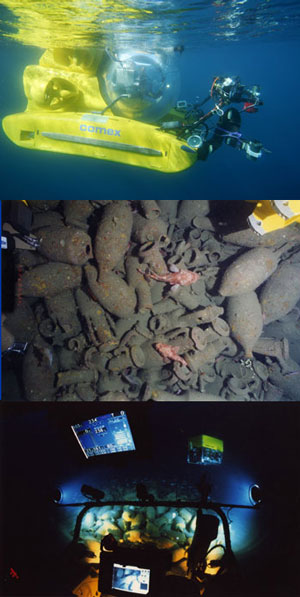VENUS: Virtual ExploratioN of Underwater Sites: Port-Miou C wreck, Marseille
Pierre Drap, 2009. https://doi.org/10.5284/1000004. How to cite using this DOI
Data copyright © VENUS: Virtual ExploratioN of Underwater Sites unless otherwise stated
This work is licensed under the ADS Terms of Use and Access.

Primary contact
Pierre
Drap
LSIS umr CNRS 6168
Ecole Supérieure d'Ingénieur de Luminy
ESIL, Ecole Supérieure d'Ingénieur de Luminy
Case 925
13288 Marseille Cedex 09
France
Tel: +33 4 91828520
Resource identifiers
- ADS Collection: 936
- DOI:https://doi.org/10.5284/1000004
- How to cite using this DOI
Overview

Since the beginning of the Venus project, the Port-Miou C roman shipwreck has been chosen as a very good opportunity to develop new technologies in order to get a virtual exploration of an underwater site.
This roman shipwreck was discovered in October 1998 by Henri-Germain Delauze, Comex Cie president, during a Remora submarine's diving. It lies by 105 m deep in front of the limestone coast of the Calanques, between Marseilles and Cassis, in the south of France (Bouches-du-Rhône). Two short expertises carried by the Department of Sub-aquatic and Sub-marine Archaeological Research (DRASSM, France), were planned with the same Comex submarine, in 1999 and 2001.
The wreck is located in open sea at 4 km in front of the Port-Miou calanque and 9 km from the east part of Riou island, in a vast area where six others roman wrecks were found by Comex. In this large area, among seven others roman wreck recently declared by Comex, between 90 and 110 m deep, four of them are totally destroyed by the repeated trawlers passage. These trawlers today equipped with extremely sophisticated instruments and geo-positionment-system, in order to recording shipwrecks position in order to lucrative recuperations, can touch several times the same site and ravage completely the archaeological layer of surface.
In conclusion, the site is lying in the sand but may be was preserved from the danger of fishing marine by a group of rocks all around, making trawlers in the obligation to avoid the danger and change of way.
Three main activities took place during this third sea trial of the VENUS Project:
- Photogrammetric data acquisition by Submarine Remora 2000 linked with record of accurate navigation data and multibeam survey.
- Multibeam survey of the wreck
- Data validity check during the mission
This exemplar archive aims to give a useful representative sample of the techniques employed and data types produced, and also to present a coherent archive of the survey itself.




